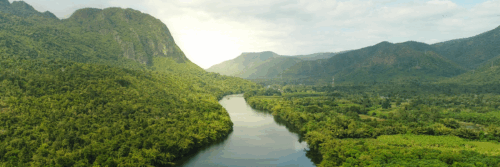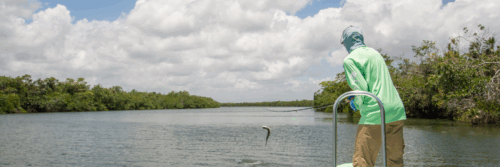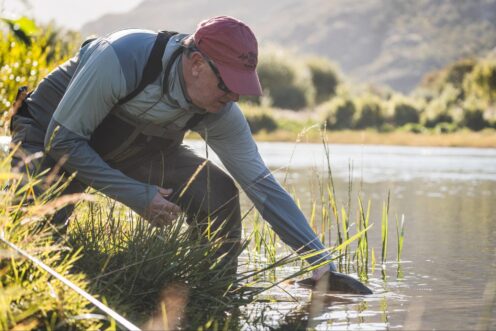
El Saltamontes 2.0 “The Grasshopper”
by Pat Pendergast
El Saltamontes, located in the Valley of the Moon in Patagonia, Chile, has a fabled fly fishing history. Originally discovered by Art Bloom a globe-trotting whitewater guide and fly fisher in the early 80s, the 5,000-acre ranch was the first regulated catch-and-release trout fishery in Chile and remains one of the best wild resident brown trout fisheries in South America! Eight miles of the Ñireguao (Nee-Dee-Wow) River flow behind locked gates at Saltamontes, bordered by pastures choked with grasshoppers – a dry fly fisher’s paradise.
My first trip to “Grasshopper” was back in 1997, three months after I moved to Redding from Alaska to help Mike and Bertha Michalak in their Travel Department. It was my first trip to Chile and a real eye-opener to rural Patagonia, an untamed land of gauchos, sheep, water, mountains and trout. Chile is still wild and agrarian, most of the roads are still gravel, and sightings of a farmer driving a team of oxen yoked to a wooden-wheeled cart laden with firewood is not uncommon. The fisheries are more spread out and harder to access than across the border and the browns and rainbows are naturally keyed to terrestrials. It’s a land of contrasts – tracts of heavily-forested steppes, high-desert landscapes, impenetrable temperate rainforests and fjords, bookended by the snow-capped Andes that supply clean, cold water to resident trout. Chile’s fly fishing history is far less than 50 years, unlike the fishing on the east side of the Andes. Most locals fish spoons thrown off an old coffee can and there are still fisheries where trout have never seen a fly – imagine that!
That first trip set the bar for all of South America trout fishing for me. I love Chile, the people, culture, food and fishing. Over the last 28 years I have made semi-annual sorties to Chile, and El Saltamontes is always on the top of my list. In 2025 I was again readying my kit for a 24-day trip in Chile with my wife…and of course a stay at Saltamontes.
Road Trip
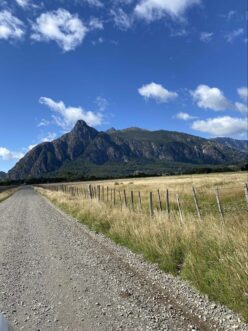
On our last day at Patagonian BaseCamp, we woke up at 7:30 AM, had a quick breakfast, saw the guests off for their fishing day and then packed, checked e-mails, and departed at 10:00 AM for El Saltamontes, a four hour drive. We drove south on the Carretera Austral Route 7 (Pan-American Highway) through the village of La Junta, then along the Puyuhuapi Fjords where we spotted pods of porpoises free-swimming. We left the coast and started driving east through the pass at Queulat National Park with its breathtaking views of hanging glaciers, and waterfalls gushing with all the recent rains. We dropped out of the pass down along the Rio Cisnes and took a pit-stop at Piedra el Gato, viewing the unrunnable rapids before continuing south past Lago las Torres and then dropping down into the hill country. That’s where things got interesting… Marcel, owner of Patagonian BaseCamp and our trusty driver, wanted to see some new country and took a left turn on a gravel road that, on a map, appeared as though it would route us to Villas el Gato, the small village just outside the gates of El Saltamontes. Wrong road, it dead-ended. We turned around, drove back to Route 7 and – “What’s that, a pair of waders in the road?” A pair of waders had flown out of the bed of the truck earlier – wow, how lucky! We took the next left and drove through some gorgeous and lonely country past the Toqui Mine, and at the Y in the road veered left. After driving for 30 minutes or so, crossing a river and going through three gates, the road ended at a cliff overlooking a gorgeous river. We drove back the way we came, talked to a local and found the correct road past Lago Norte to El Gato…two hours late, but we made it! Dane Emerson, is there to meet us – he shows us to our rooms, and we have a quick bite of lunch with Marcel and Dane. Dinner was Chicken Cordon Bleu, Chilean-style, very tasty. What a roadtrip, we loved it!

Authentic Patagonia Cuisine
Dinners at El Saltamontes are an event and something that has been etched in my mind since my first visit. The large dining room table is set beautifully with candelabras, roaring fireplace, soft music playing in the background and more silverware and glasses than you can imagine – love it! Dane (a foodie) takes time each evening to explain the dishes with descriptions of the ingredients, history of the dishes, their relationship to Patagonia, and why they were selected as well as the wine pairings. Dinner started with cold tenderloin with a cream sauce and tuna – interesting and very tasty. Tonight we had a traditional family meal – milanesa, papas fritas (French fries), green salad, and a vinegar carrot salad, served “country style” – with a dessert of cream bread pudding with dulce de leche, all incredibly delicious.
Home Water
Lisa and I are fishing with Mauricio “Mauri” (former head guide for Patagonia River Guides) and photographer Leandro Herrainz (former head guide at Kau Tapen on the Rio Grande). We head down river to the property boundary and Beat One. Today we will fish from shore, all upstream walk and wade, using a pickup to move to other sections of the beat. We are fishing terrestrials for the day, dries for me and a dry dropper rig for Lisa. We land a ton of fish, mostly rainbows and a few browns. Walking along the river, hordes of hoppers scatter in front, and those dropping into the river are immediately eaten by triggered trout. It’s cool to just watch the feeding frenzy! Of course when you throw your hopper in the water, 9 times out of 10 it is immediately eaten. We had lots of sight-fishing opportunities and you could make the fishing as easy or as difficult as you liked. Leandro and I ended up sharing a rod and sight-fishing to trout in difficult lies. It was a blast with lots of friendly heckling on blown shots. We had a lovely lunch with table, tablecloth and chairs, pork tenderloin, wine, beer, sodas, the works! At lunch we spotted a red stag on the mountain and saw tons of pheasants, quail, a condor, an eagle, and one mean Angus bull… a great first day and super chill. It was great to be able to free roam and sight fish all day with Leandro – we had a lot of fun! Lisa had Mauri to herself for the day and learned a ton from him. Not only is he one of the best guides in all Patagonia, he is a certified casting instructor and one of the nicest people you will ever meet – a wonderful human being.
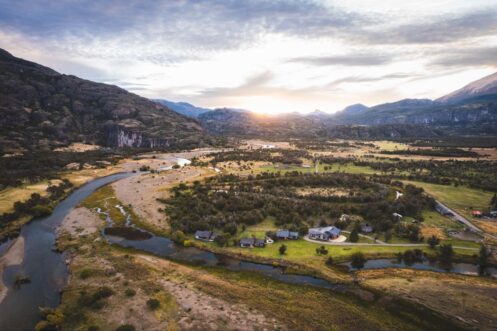
Quick Fact
The wildfire that ravaged Chile, Patagonia, 100 years ago was caused by settlers clearing land. It burned for 10 years, scorching over 2.8 million hectares (7 million acres). The town of El Gato (at the entrance of Saltamontes) was named after wild cats, including pumas, that migrated to the creek to escape the fire.
Lake Fishing
Lisa and I are fishing Lago Norte with “Benji” Benjamin Salles, Sebastian’s brother (who also guides for Saltamontes). We are joined by Brian from The Northern Angler Fly Shop in Traverse City, MI, and his lady friend, Jen. Martin “Fuzzy” is their guide – it’s a super fun group. I am not a huge still-water fan, but if I can take nice brown trout on a big dry fly, I am all in. Lisa and I landed some nice browns on dries – nothing huge, but very strong.
Motorboat caddis were present and some fish were eating them. The wind was not bad at all. Lunch was taken in the Glass House – lentil stew, which was delicious. It was a nice, relaxed day – Benji is a sweetheart, hard-working, and very attentive. We fished out of new catarafts with equally new Yamaha 25-horsepower outboards. Dinner was thinly-sliced beets and Ossobuco (slow-cooked veal shank) with polenta, finished with a calafate berry crème brûlée- all very rich and scrumptious. This was my favorite meal so far at El Saltamontes.
Hopper Time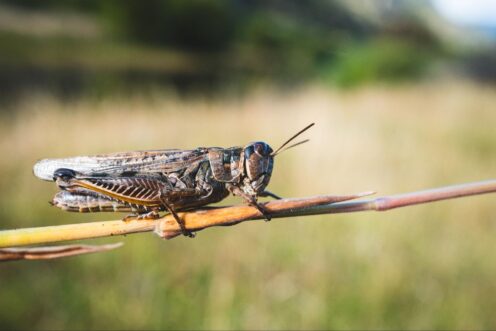
We are headed to the Seventies beats today to fish on Richard Spring Creek and the Ñireguao with Samuel Gonzalez, Nico Gonzalez’s “Trouters Patagonia” son. It’s a walk and wade day that starts off with a 17-kilometer drive southeast toward the village of Ñireguao. We park the pickup and walk downstream for about 15-20 minutes to where the spring creek joins the Ñireguao, then cross the river and fish up the creek. The wind is howling today. We catch a few small fish, the biggest about 14 inches, and do see some larger fish eating live hoppers landing in the river, but they are not interested in our flies. There are clouds of hoppers on the grass banks.
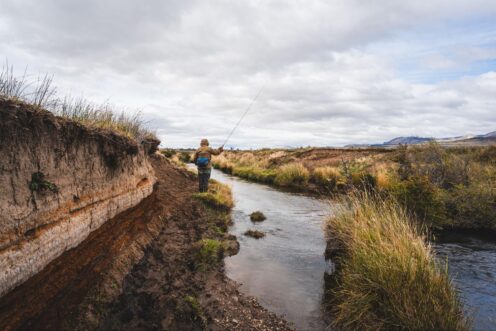
We take a quick lunch then hike back down to the Ñireguao and fish upstream toward the truck, with excellent action on terrestrials for fish averaging about 15 inches. Two fish stick out in my mind on this day. #1) I was fishing a wide, bumpy riffle upstream and cast a tan Chubby Chernobyl in the middle, then watched as a nice 17-inch brown trout streaked out 8 feet from under the bank and crushed my dry…super visual and fun to watch! #2) I was fishing a wide part of the river – on the far side were pockets of calm water, each with a cutbank and fast-moving water in front. I made a long cast into a pocket, got in a feeble mend and the fly had sat motionless for a couple of seconds when a big brown lazily ate. I set and the fish immediately darted back under the bank into cover and broke off. Damn, that was a really nice brown, well in excess of 20 inches! All in all, it was a fun day – the afternoon fishing on the Ñireguao was much more productive than the spring creek, and we enjoyed plenty of action.
El Gato Creek
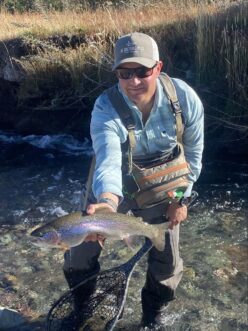
It’s our last day at El Saltamontes. We say goodbye to Mauricio, he is headed back to Argentina – such a super nice and happy man. Dane and I decide to take most of the day off from fishing, as we both have some correspondence to take care of. However, it’s a lovely day, sunny with light winds, and by the time afternoon rolls around we head off to fish Beat Four on the Ñireguao above the lodge for a couple of hours. Immediately Dane is into fish on a riffle at the mouth of El Gato Creek, which only means one thing – a push of trout have moved up into the small tributary to gorge on hoppers, of which there are literally thousands. We fish our way upstream with hopper imitations and seldom does a good dead-drift go unrewarded. You can see every trout you cast to and they are so focused on devouring hoppers; not at all spooky. We land a dozen or so fish in short order, some really nice rainbows that are fat and sassy, stuffed to the gills with hoppers. Even though it was a short afternoon session it was really fun to fish with Dane and the fishing was downright silly. What a way to end the week, nice big trout eating hopper flies…
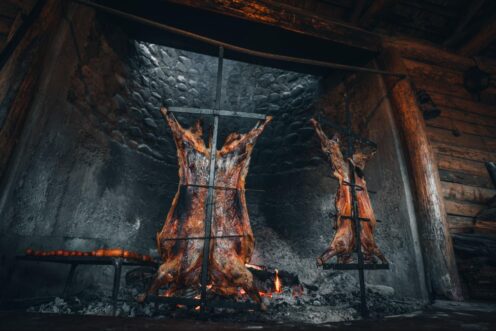
Asado Night
As has been the tradition since El Saltamontes first opened, the last night is celebrated with an asado, a traditional South American barbeque which takes place in the quincho. Quinchos range from a circle of rocks around a campfire to a corner in the barn, or even an elaborate building surrounding an open fireplace. Always a social event, few are more entertaining or anticipated as those at El Saltamontes. A whole butterflied lamb is staked on a vertical spit and slowly cooked over open flame, and accompanied by sausages and other meats, all complemented by chimichurri (a zesty sauce), salads, bread, and of course lots of Carménère, Chile’s signature red wine. It was a great party with lots of delicious food, wine, song and fun – a perfect sending off after a wonderful week of angling.
Wrap Up
El Saltamontes is the perfect location for folks that like to fish medium to small-sized rivers with dry flies, especially hoppers and other terrestrials. The majority of the fishing is done wading, though they do incorporate a couple of floats in the weekly angling menu as well as an opportunity to fish a lake.
Our week at El Saltamontes was wonderful! For the first year of operation under Dane and Chiara’s management, they knocked it out of the park. It was everything that I remembered from my first trip with the added advantage of Dane running point on the fishing program, and Chiara handling the hospitality side of things. The meals were amazing, varied, traditional Patagonian fare and painstakingly created by talented chefs. The accommodations were very comfortable and Dane and Chiara will continue to make upgrades to the guest cottages. The fishing is a wonderful mix of water and Dane will expand the options, adding more private water and exploring local fisheries not historically fished from the lodge. All of the guides were very fishy, hard-working, polite, and were driven to show guests a great fishing day without being pushy or overbearing – a very nice touch.
Under the thoughtful guidance and leadership of Dane and Chiara, two of the most talented and capable outfitters I know, the new El Saltamontes 2.0 is fresh, modern, and progressive without losing the authentic Patagonia feel. The experience will continue to evolve and get better and I can’t wait to return to Patagonia, Chile, and El Saltamontes.
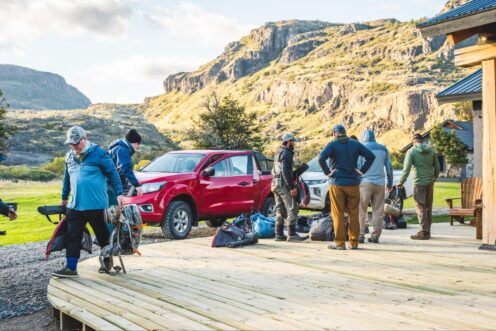
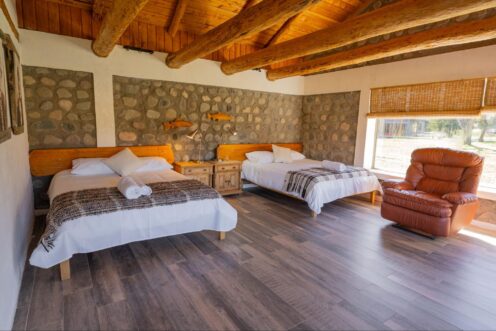
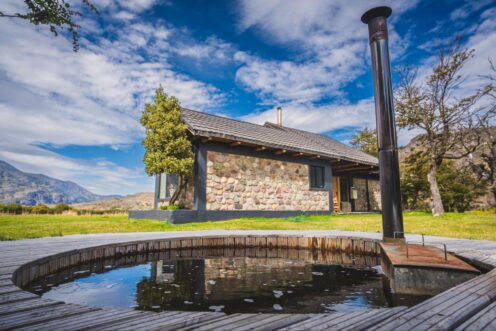
What I Fished at El Saltamontes: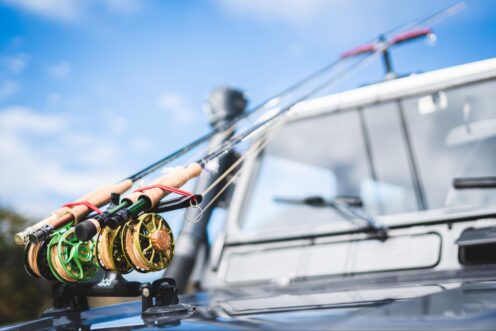
- Rods
- Reels
- Fly Line
- Waders
- Wading boots
- Clothing
- Sunglasses
If you would like to learn more about El Saltamontes, please feel free to contact me.
Muchos Saludos,
![]()
Pat Pendergast
(530) 222-3555 | (800) 669-3474 | pat@theflyshop.com

